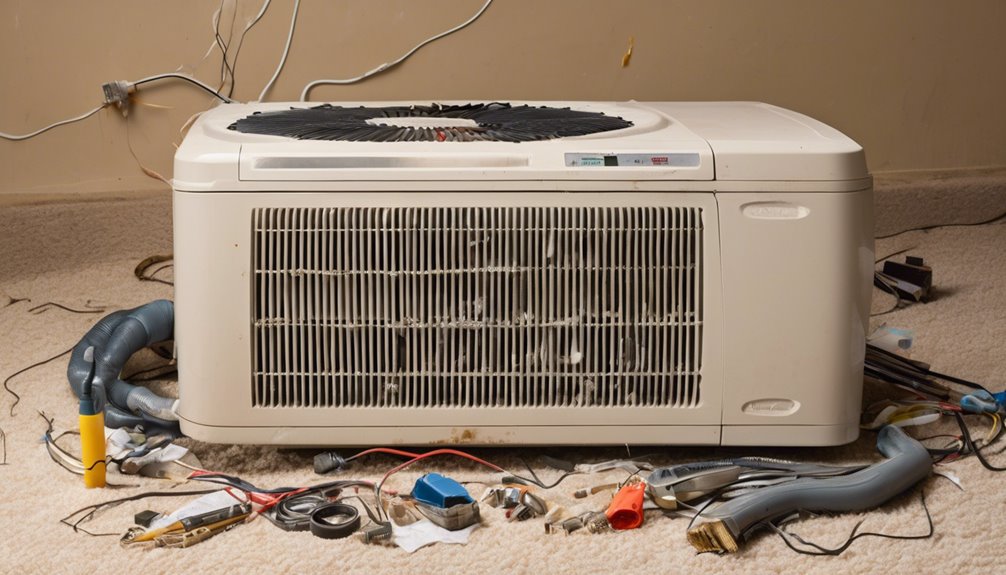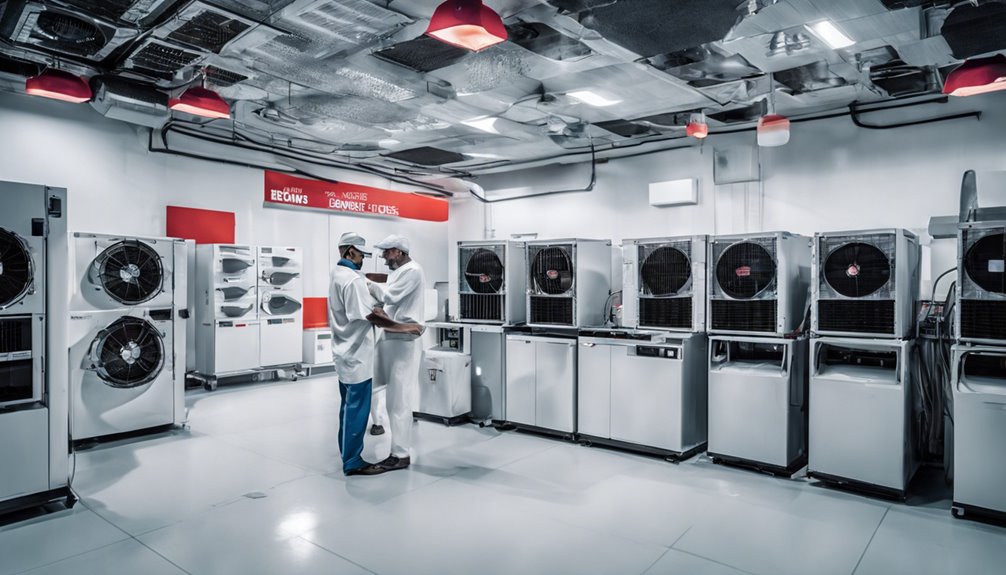When your AC isn't cooling, try checking the thermostat settings to ensure it's set low enough and in summer mode. Also, remove any obstructions from air vents and inspect the ventilation system design. Don't forget to clean or replace the air filter, and inspect and clean the condenser coils for optimal airflow. If you're still having issues, check for refrigerant leaks, verify the AC's power source, and look for frozen coils or icing. Want to troubleshoot further and get your AC running smoothly?
Key Takeaways
- Check thermostat settings for Summer mode and ensure temperature is set low enough to trigger AC to turn on.
- Regularly clean or replace air filters to prevent reduced airflow and system breakdowns.
- Inspect and clean condenser coils to ensure optimal airflow and prevent reduced cooling capacity.
- Verify a stable power supply to the AC and inspect for refrigerant leaks around connections and valves.
- Check for frozen coils or icing on the outdoor unit and defrost by turning off the AC and letting it thaw.
Check the Thermostat Settings
Your thermostat is the brain of your air conditioning system, so it's a good place to start when troubleshooting cooling issues.
Check if it's set to Summer mode, which is usually the default setting for cooling. Make sure the temperature is set low enough to trigger the AC to turn on.
A common issue is temperature fluctuation, which can cause the AC to malfunction. Ensure the thermostat is set to a consistent temperature, and the AC isn't overheating or overcooling.
Also, check if the thermostat's battery is working properly, as a dead battery can prevent the AC from functioning.
Ensure Proper Airflow
Proper airflow is essential for your air conditioner to function efficiently.
You should ensure that air can circulate freely throughout your home. Check for any obstructions, such as furniture or curtains, that might be blocking air vents. Rearrange them to allow for better air circulation optimization.
Also, inspect your ventilation system design to ensure it's designed to facilitate smooth airflow. Make sure all windows and doors are sealed tightly to prevent hot air from entering and cool air from escaping.
Clean or Replace Air Filters
You've ensured proper airflow, but now it's time to tackle another crucial aspect of AC maintenance: cleaning or replacing air filters.
If you're noticing reduced airflow, increased energy bills, or dust accumulation, it's likely your filter is dirty and impeding your AC's performance.
Dirty Filter Symptoms
A dirty air filter can wreak havoc on your air conditioner's performance, leading to a multitude of issues that can drive up your energy bills and compromise your comfort.
You'll notice your AC is working harder, making strange noises, or producing weak airflow. It's time for a filter inspection!
Check your filter monthly, especially during peak usage. If it's dirty, you'll see a thick layer of dust, dirt, or debris.
Regular filter maintenance is key to preventing these issues. A dirty filter reduces airflow, causing your AC to work overtime, which increases energy consumption and wear on the system.
Filter Replacement Tips
Your air filter's condition dictates your AC's performance, so it's crucial to clean or replace it regularly. Neglecting filter maintenance can lead to reduced airflow, increased energy bills, and even system breakdowns. To avoid these issues, prioritize filter upgrading and replacement.
| Filter Type | Replacement Frequency |
|---|---|
| Disposable | Every 1-3 months |
| Washable | Every 2-4 months |
| HEPA | Every 6-12 months |
| Custom | Check manufacturer's instructions |
Cleaning Filter Methods
Cleaning your air filter regularly is just as important as replacing it.
When you clean your filter, you're not only improving airflow but also enhancing air purification.
For filter maintenance, start by turning off your AC unit and removing the filter.
Gently tap the filter to loosen any debris, then vacuum it using a soft-brush attachment.
For more thorough cleaning, mix a solution of warm water and mild dish soap, and gently scrub the filter with a soft-bristled brush.
Rinse thoroughly and let it dry before reinstalling.
Remember to clean your filter every 1-2 months, depending on usage, to ensure optimal air purification and AC performance.
Inspect and Clean the Condenser Coils
You'll typically find the condenser coils located outside, either on the side or back of your AC unit, which is crucial to remember when inspecting and cleaning them.
When it comes to removing debris, you'll want to use the right methods to avoid damaging the coils, and having the right tools can make all the difference.
Coil Location Matters
The condenser coils, usually located outside, play a crucial role in dissipating heat from the refrigerant in your air conditioner.
You should ensure they're placed in a spot that allows for optimal airflow. Coil placement is key – if they're too close to walls or other obstructions, air can't circulate properly, reducing efficiency.
Additionally, consider outdoor shading – direct sunlight can increase temperatures, making your AC work harder. Try to position your coils in a shaded area or use a canopy to block the sun's rays.
Debris Removal Methods
Debris accumulation on the condenser coils can significantly impede your air conditioner's performance, leading to increased energy consumption and reduced cooling capacity.
To remove debris, start by turning off the power to your AC unit at the circuit breaker or fuse box. Then, use a leaf blower to gently blow away any loose debris, such as leaves or twigs, from the coils.
Next, use a garden hose to spray the coils, making sure to spray from the inside out to avoid pushing debris further into the coils. This should loosen and remove any remaining dirt and debris. Be careful not to use high pressure, as this can damage the coils.
Coil Cleaning Tools
Now that you've removed loose debris, it's time to get down to business and really clean those coils.
You'll need the right tools for the job. A coil brush is a must-have for reaching deep into the coils and dislodging stubborn dirt. When choosing a coil brush, read reviews to find one that's sturdy and effective – a good coil brush review can make all the difference.
If you're dealing with heavy buildup, consider a coil scrubber. Compare different models to find the best one for your needs – a coil scrubber comparison can help you make an informed decision.
With the right tools, you'll be able to give your coils a thorough cleaning and get your AC running smoothly again.
Check for Refrigerant Leaks
You'll want to inspect the entire AC system for signs of refrigerant leaks, as these can cause your air conditioner to malfunction or fail altogether.
Look for signs of oil or refrigerant residue around connections, valves, and joints. Use refrigerant detection tools, such as leak detectors or UV dye, to help identify potential leaks.
Perform a leak inspection on the coils, compressor, and other components. If you find a leak, turn off the AC and avoid using it until the issue is resolved.
Remember to always follow safety guidelines when handling refrigerants, and consider hiring a professional if you're unsure about the process.
Verify the AC's Power Source
The air conditioner's power source is a crucial component to inspect when troubleshooting cooling issues. You should ensure the AC is receiving a stable power supply to function efficiently. Check your circuit breaker or fuse box to verify that the breaker hasn't tripped or a fuse hasn't blown. A power surge or voltage fluctuation can cause the AC to malfunction.
| Causes | Effects | Solutions |
|---|---|---|
| Power Surge | AC won't turn on | Check circuit breaker or fuse box |
| Voltage Fluctuation | AC's performance is poor | Ensure stable power supply |
| Overloaded Circuit | AC trips frequently | Distribute power load evenly |
| Faulty Wiring | AC doesn't receive power | Inspect and repair wiring issues |
Look for Frozen Coils or Icing
Inspect the AC's outdoor unit for frozen coils or icing, a common culprit behind cooling issues.
You can spot frozen coils by looking for a thick layer of ice or frost on the coils. Defrost the unit by turning off the AC and letting it thaw.
Spot frozen coils by looking for thick ice or frost layers, then defrost by turning off the AC and letting it thaw.
Ensure good airflow around the unit to prevent future freezing. Check the air filter, as a dirty filter can cause the evaporator coil to freeze.
Perform regular coil maintenance to prevent icing issues. A frozen evaporator coil can significantly reduce your AC's cooling performance.
Check the Capacitor and Contactors
Faulty capacitors and contactors can also hinder your AC's cooling performance.
These components play a crucial role in powering the compressor and fan motor. If they're malfunctioning, your AC won't cool effectively.
To troubleshoot, follow these steps:
1. Check the capacitor for signs of wear, such as swelling or burning smells. You may need to replace it if it's faulty.
Perform capacitor testing to ensure it's functioning correctly.
2. Inspect the contactors for corrosion or pitting.
Clean them gently with a soft brush to remove dirt and debris. Regular contactor maintenance can prevent issues.
3. Verify that the contactors are engaging properly.
If they're not, you may need to replace them or adjust the settings.
Check for Blockages in the Vents
Blockages in your AC's vents can severely impede airflow, causing your system to work harder and reducing its cooling performance. When you're experiencing an AC cooling issue, it's essential to inspect your vents for any blockages. This includes checking for dust, dirt, or debris accumulation, as well as ensuring that furniture or other objects aren't obstructing the airflow.
| Vent Inspection Area | Potential Blockage | Solution |
|---|---|---|
| Supply vents | Dust, dirt, or debris | Vacuum or brush clean |
| Return vents | Furniture or objects | Rearrange or remove obstacle |
| Ducts | Kinks or bends | Straighten or replace ducts |
Frequently Asked Questions
Can I Fix My AC Myself or Do I Need a Professional?
You're wondering if you can fix your AC yourself or need a pro? Before calling a technician, try some AC troubleshooting basics, but know your DIY limitations – if you're unsure or uncomfortable, it's best to call a professional to avoid further damage.
Will Cleaning the AC Filters Improve Its Cooling Performance?
You'll be surprised how much cleaning the AC filters can boost performance! By removing airflow restrictions, you'll improve circulation and cool air delivery. Moreover, upgrading to high-quality filters will further enhance airflow, making your AC work more efficiently.
How Often Should I Inspect and Clean My AC Condenser Coils?
You should inspect and clean your AC condenser coils every 2-3 months, or during seasonal checks, as part of regular coil maintenance to ensure optimal airflow and prevent reduced cooling performance.
Can a Faulty Thermostat Cause My AC to Malfunction?
You're wondering if a faulty thermostat is causing your AC to malfunction? Yes, it can! A faulty thermostat can lead to temperature fluctuations, and incorrect thermostat calibration can prevent your AC from cooling properly, making your home uncomfortably warm.
Will Using a Dehumidifier Help My AC Cool More Efficiently?
You'll be happy to know that running a dehumidifier can help your AC cool more efficiently by reducing humidity levels and removing excess moisture from the air, allowing your AC to focus on cooling rather than fighting humidity.
Conclusion
You've checked everything from thermostat settings to blockages in the vents, and hopefully, you've identified and fixed the issue with your AC's cooling performance. If not, it may be time to call a professional. Remember, regular maintenance can go a long way in preventing these problems. By following these steps, you've taken a crucial step in keeping your AC running smoothly and efficiently.



